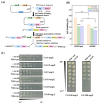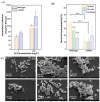Limited Role of Rhamnolipids on Cadmium Resistance for an Endogenous-Secretion Bacterium
- PMID: 36231857
- PMCID: PMC9566264
- DOI: 10.3390/ijerph191912555
Limited Role of Rhamnolipids on Cadmium Resistance for an Endogenous-Secretion Bacterium
Abstract
Rhamnolipids, a type of biosurfactant, represent a potential strategy for both enhancing organismic resistance and in situ remediation of heavy metals contaminations. In-depth study of the mechanism of rhamnolipids synthesis in response to heavy metals stress, is indispensable for a wide use of biosurfactant-secreting microbes in bioremediation. In this study, we employed the wild-type and the rhlAB deficient strain (ΔrhlAB) of Pseudomonas aeruginosa, a prototypal rhamnolipids-producing soil microorganism, to investigate its responses to cadmium resistance based on its physicochemical, and physiological properties. Compared with the wild-type strain, the ΔrhlAB were more sensitive to Cd-stress at low Cd concentration (<50 mg/L), whereas there was little difference in sensitivity at higher Cd concentrations, as shown by spot titers and cell viability assays. Secreted rhamnolipids reduced intracellular Cd2+ accumulation to alleviate Cd2+ stress, whereas endogenous rhamnolipids played a limited role in alleviating Cd2+ stress. Synthesized rhamnolipids exhibited a higher critical micelle concentration (CMC) (674.1 mg/L) and lower emulsification index (4.7%) under high Cd-stress, while these parameters showed no obvious changes. High Cd-stress resulted in high hydrophilic wild-type bacterial surface and lower bioremediation ability. This study could advance a deeper understanding of the mechanism of cadmium resistance and provide a theoretical foundation for the application of biosurfactant and biosurfactant-secreted bacterium in contaminant bioremediation.
Keywords: biosurfactants characteristics; cadmium stress; cytotoxicity reduction; endogenous rhamnolipids.
Conflict of interest statement
The authors declare no conflict of interest.
Figures





Similar articles
-
Effects of rhamnolipids from Pseudomonas aeruginosa DS10-129 on luminescent bacteria: toxicity and modulation of cadmium bioavailability.Microb Ecol. 2010 Apr;59(3):588-600. doi: 10.1007/s00248-009-9626-5. Epub 2010 Jan 15. Microb Ecol. 2010. PMID: 20082071
-
Oxygen effects on rhamnolipids production by Pseudomonas aeruginosa.Microb Cell Fact. 2018 Mar 9;17(1):39. doi: 10.1186/s12934-018-0888-9. Microb Cell Fact. 2018. PMID: 29523151 Free PMC article.
-
High mono-rhamnolipids production by a novel isolate Pseudomonas aeruginosa LP20 from oily sludge: characterization, optimization, and potential application.Lett Appl Microbiol. 2024 Feb 1;77(2):ovae016. doi: 10.1093/lambio/ovae016. Lett Appl Microbiol. 2024. PMID: 38366661
-
Effects of rhamnolipids on microorganism characteristics and applications in composting: A review.Microbiol Res. 2017 Jul;200:33-44. doi: 10.1016/j.micres.2017.04.005. Epub 2017 Apr 13. Microbiol Res. 2017. PMID: 28527762 Review.
-
Pseudomonas aeruginosa rhamnolipids: biosynthesis and potential applications.Appl Microbiol Biotechnol. 2000 Nov;54(5):625-33. doi: 10.1007/s002530000443. Appl Microbiol Biotechnol. 2000. PMID: 11131386 Review.
Cited by
-
Novel Insights into Cr(VI)-Induced Rhamnolipid Production and Gene Expression in Pseudomonas aeruginosa RW9 for Potential Bioremediation.J Microbiol Biotechnol. 2024 Sep 28;34(9):1877-1889. doi: 10.4014/jmb.2406.06034. Epub 2024 Jul 19. J Microbiol Biotechnol. 2024. PMID: 39343606 Free PMC article.
References
-
- Módenes A.N., de Abreu Pietrobelli J.M.T., dos Santos G.H.F., Borba C.E., da Silva Sá Ravagnani M.A., Espinoza-Quiñones F.R. Multi-component mathematical model based on mass transfer coefficients for prediction of the Zn and Cd ions biosorption data by E. densa in a continuous system. J. Environ. Chem. Eng. 2018;6:5141–5149. doi: 10.1016/j.jece.2018.08.001. - DOI
Publication types
MeSH terms
Substances
LinkOut - more resources
Full Text Sources

